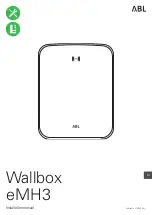
en
GARANT GridLine laptop and battery charging cabinet
4.2. INTENDED USE
Keep doors’ swing range unobstructed, keep doors and drawers
closed.
For work in indoor industrial environments. For use on dry solid
floors.
Use only in a technically perfect and safe condition.
Incl. type F plug sockets.
4.2.1. Laptop cabinet
For charging smartphone, tablet, laptop and similar.
Every compartment incl. 240-V earthed plug socket type F and
USB 2.0 type A port.
4.2.2. Battery charging cabinet
For charging rechargeable batteries.
Only charge batteries with the fan running.
With 5-pin 400-V/16-A (3P+N+E) plug for connecting to three-
phase outlet socket.
Requires wall mounting.
4.3. REASONABLY FORESEEABLE MISUSE
Do not make any unauthorised changes or modifications.
Do not use in potentially explosive atmospheres.
Not for use in areas where high concentrations of dust, flam-
mable gases, vapours or solvents are present.
Do not overload cabinet, drawers and storage shelf.
Do not climb into or sit on cabinet, drawers or storage shelf.
Do not place objects on cabinet shell that will extend beyond its
edge.
4.3.1. Battery charging cabinet
Keep fan and ventilation slots clear and uncovered.
Do not by-pass the fuses.
4.4. QUALIFICATIONS OF PERSONNEL
Specialists for mechanical work
Specialists in the sense of this documentation are persons who are
familiar with assembly work, mechanical installation, commission-
ing, troubleshooting and maintenance of the products and who
possess the following qualifications:
Qualification / training in the field of mechanics as specified in
the nationally applicable regulations.
Trained specialist for electro-technical work
A trained electrician in terms of this document is a person who has
been respectively trained and who possesses the skills and experi-
ence to recognise and avoid the dangers of working with electricity.
Trained person
Trained persons in the sense of this documentation are persons
who have been trained to perform work in the areas of transport,
storage and operation.
5. Setting up
Set up on a solid, level floor with maximum load-bearing capa-
city.
Ambient temperature: -10 °C to +40 °C.
5.1. BATTERY CHARGING CABINET
Use spirit level to check horizontal levelling. If necessary,
Size 1000/DE and 1250/DE: Maintain a gap of at least four cm
between cabinet rear and wall.
5.1.1. Adjusting adjustable base
A
NOTICE
Limited load-bearing capacity
Damage from overloading adjustable base.
» When using the adjustable base, note load-bearing capacity re-
duced to 500 kg.
» Before adjusting the adjustable base, completely clear out the
cabinet.
» Do not screw the adjustable base’s thread all the way in. Keep
0.5 cm of thread protruding.
ü
Cabinet is completely empty.
1. Take lower storage shelf out of cabinet by lifting it at the holes
on the sides.
CAUTION! Risk of cuts. Wear safety gloves.
2. Adjust four levelling feet inside the cabinet using a 5-mm Allen
key.
3. Use a spirit level to check horizontal levelling.
4. Repeat procedure until cabinet is perfectly level.
5.1.2. Wall mounting
B
i
Applies to: Battery charging cabinet. Do not mount on wall by your-
self.
CAUTION
Cabinet, roller cabinet or rack toppling
Risk of injury to hands, feet or body.
»
It is essential the cabinet is secured against toppling.
» Wear safety shoes and safety gloves.
» Do not store workpieces unsecured.
» Do not open several drawers at once.
» Keep cabinet shell cover clear of objects during transport.
» Set down heavy objects slowly.
» Ensure during movement and transport that all drawers and cup-
board doors are closed and locked.
» Comply with the maximum load capacity.
NOTICE
Wiring and pipes in wall
Damage to wiring and pipes.
» Check wall for sufficient load-bearing capacity before drilling.
» Use suitable drilling tools and materials.
» Use suitable protective equipment.
» Have trained personnel drill holes.
» Do not drill holes close to wiring or pipes.
ü
Wall plugs and screws chosen to match wall.
ü
Floor has sufficient load-bearing capacity.
1. Mark drilling spots through the holes in the cabinet’s rear and
move cabinet out of the way.
2. Drill holes in wall, insert wall plugs and screw cabinet to wall.
6. Assembly
CAUTION
Assembly work
Risk of crushing feet or hands when assembling and when closing
drawers.
» Wear safety shoes and safety gloves.
» Ensure safe footing on clean, level surface.
» Do not assemble by yourself.
Instruction manual
10











































